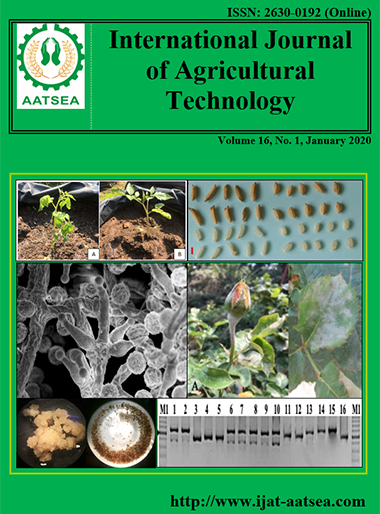A Study on the Mechanical Characteristics of Cassava Tuber Cutter
Main Article Content
Abstract
The mechanical characteristics of cassava tuber cutter were determined the mechanical behaviour and its effect during shear cutting and evaluatedvariables (maximum cutting shear force, maximum cutting shear stress, specific cutting energy and amount of post-cutting loss) using 4 cutting tilt angles (30°, 45°, 60° and 90°) and 4 cutting speeds (20, 40, 60 and 100 mm/min). These variables were set in order to provide basic information and guidelines to design the cutting blade of the cutting machine to separate cassava tuber from its rhizome. The cassava variety of Kasetsart 50 was tested with tuber ages of 10-12 months, planted in the area of Mueang district, Khon Kaen province. A universal testing machine with maximum force of 50 kN was operated. The test results indicated that the maximum cutting shear force and the maximum cutting shear stress increased with increasing tuber age which was due to the increase in density and starch content. The cutting tilt angle at 30° with the cutting speed at 100 mm/min provided the least values for the maximum cutting shear force, the maximum cutting shear stress and the specific cutting energy. For tubers aged 10, 11 and 12 months, the average maximum cutting shear forces were 1.61±0.61, 3.60±0.24 and 4.08±0.11 kN respectively, while the average maximum cutting shear stresses were 2.01±0.76, 7.20±0.12 and 8.17±2.97 MPa respectively and the average specific cutting energieswere 24.74±15.56, 26.15±10.81 and 30.38±11.10 mJ/mm2 respectively. The amounts of post-cutting loss were slightly different within the range of 0.5-1% for different tuber ages.
Article Details

This work is licensed under a Creative Commons Attribution-NonCommercial-NoDerivatives 4.0 International License.
References
ASAE standards (1998). Compression test of food materials of convex shape. ASAE S368.3 MAR95, 554-559.
Arsawang, S., Chansrakoo, W., Chamsing, A., Sangphanta, P. and Chawkongchak, S. (2016). Design and Development of Cassava Root Plucking Out Machine. Agricultural Science, 47:463-466.
Bunart, S. (2000). Design and Development of a Tractor-Mounted Cassava Root Collector. (Master Thesis). of Engineering Program, Department of Agricultural Engineering, Bangkok, Kasetsart University, Bangkok Graduate College.
Chancellor, W. J. (1958). Energy requirements for cutting forage, Agricultural Engineering, 39: 633- 640.
Chattopadhyay, P. S. and Pandey, K. P. (1998). Mechanical Properties of sorghum stalk in relation to quasi static deformation, Journal of Agricultural Engineering Research, 73:199-206.
Chiawchanwattana, C. (2006). The Study and Development of A Cssava Transporter After Harvesting. (Master Thesis) of Engineering Program, Department of Agricultural Engineering, KhonKaen University.
Chamsing, A., Senanarong, A., Sngiamphongse, S., Sutthiwaree, P., Ksaehancharpong, Y., Wannarong, K. and Sangphanta, P. (2009). Research and Development of Moldboard Plow Type Cassava Digger. TSAE Journal, 15:13-18.
Heidari, A., Chegini, G., Kianmehr, M. H., Hassan-Beygi, S. R. and Khazaei, J. (2012). Influence of knife bevelangle, rate of loading and stalk section on someengineering parameters of lilium stalk Iranica, Journal of Energy & Environment, 3:333-340.
Junyusen, P., Vatakit, K., Somphong, C. and Arjharn, W. (2014). Development of a Cassava Harvester for Cutting Cassava Tuber from Rhizome. Agricultural Science, 45:353-356.
Krutz, G., Thomson, L. and Claar, P. (1994). Design of Agricultural Machinery. John Wiley and Sons. New York Chicheter Brisbne, Toronto, Sigapore, pp.472.
Khonphutsa, J. and Kitsamphanwong, A. (2012). A Study of Cutting Rhizomes from cassava root by Using circular saw. (Bachelor Thesis). of Engineering Program, Department of Agricultural Engineering, KhonKaen University.
Kutsamrong, R. and Kbrave, W. (2015). A Study Mechanical Properties of Cassava. Association Conference National Institute of Thailand, 16th and 8th International, pp.517-577.
Langkapin, J., Kalsirisilp, R. and Tantrabandit, M. (2012). Design and Fabrication of a Cassava Root Picking Machine. T. Agricultural Research Journal, 30:300 -311.
Office of Agricultural Economics (2019). Cassava export statistics. Retrieved from URL:http://www.oae.go.th/oae_report/export_import/export_result.php.
O’Dogherty, M. J., Hubert, J. A., Dyson, J. and Marshall, C. J. (1995). A study of the physical and mechanical properties of wheat straw. Journal of Agricultural Engineering Research, 62:133-142.
Persson, S. (1987). Mechanics of Cutting Plant Material, American Society of Agricultural Engineers, USA, pp.89-90.
Prapakarn, N. (2008). Study of Preliminary Parameters for Designing A biomass Cutting Machine for Biomass Gasifica Tion Power Plant. (Master Thesis). of Engineering in Mechanical Engineering, Suranaree University of Technology.
Shigley, J. E. and Mischke, C. R. (1989). Mechanical Engineering Design. 5th ed, Mcgraw-Hill Book Company, USA, pp.799.
Sarathulpitak, D., Nakhuea, T., Balanang, A., NanantaSukon, S. and kiatiwat, T. (1994). Research and development of cassava diggers. Proceeding of agricultural engineering, pp.16-38.
Suvanapa, K. and Wongpichet, S. (2015). Astudy In the use of Engineering technical feasibility a square shape blade of Cutting Cassava Tuber from Rhizome. Association Conference National Institute of Thailand, 16th and 8th International, pp.335-342.
Xue Z., Guo X. M., Huang Z. M., Wang S., Deng G. R. and Zhang, J. (2014). Research on MechanicalProperties of Cassava Stalk. J. Chinese Agricultural Mechanization, 35:83-87.
Xue, Z., Zhang J., Zhang, Y. L., Li, C. B. and Chen, S. (2015). Test and Analysis on the Mechanical Properties of Cassava Stalks. The Journal of Animal & Plant Sciences, 3:59-67.


